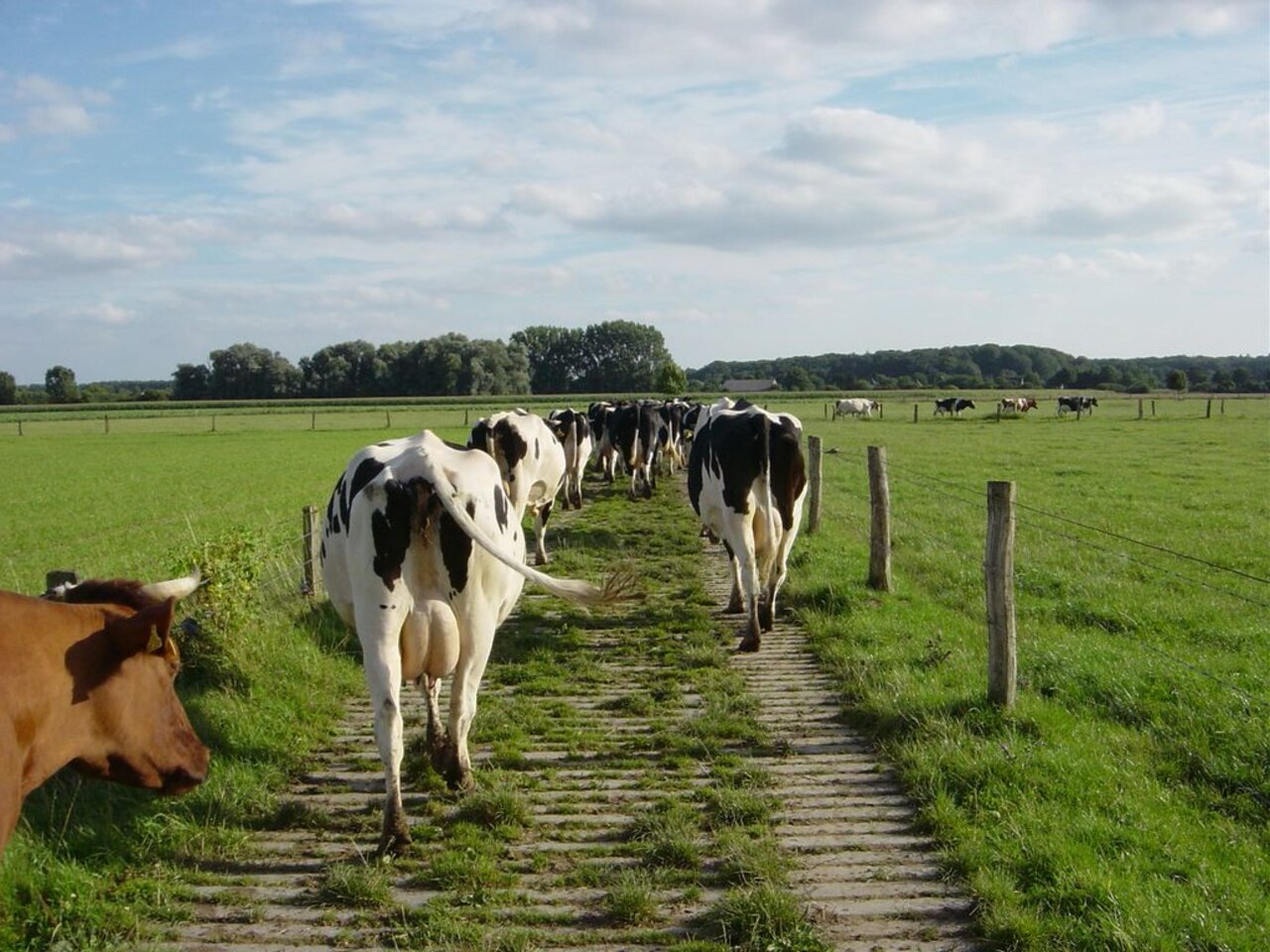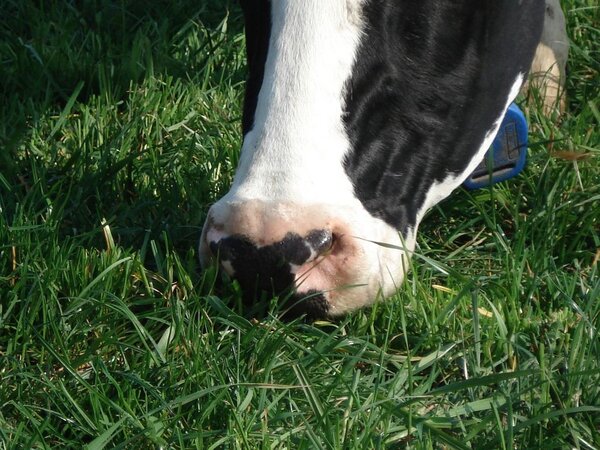Project
What effects do grassland and grazing management have on cow health and welfare?

Grazingcowhealth - Analysis of comprehensive datasets originating from Federal Organic Farming Scheme studies with regard to the impact of grassland and grazing management on cow health and welfare in organic dairy farming
Animal husbandry in organic farming calls for animal-appropriate conditions and the acceptance of behavioral habits specific to various animal species. But: How healthy is grazing management for cows?
Background and Objective
Animal appropriate husbandry practices are important for organic animal husbandry: it should be possible for animals to pursue their own species-specific behavior. Grazing management is obligatory for all ruminants in organic farming and is also the most appropriate husbandry system for cattle. With their unique digestive system, ruminants can eat plants on grassland and convert them to high value animal foods.
Dairy husbandry is a relatively intensive production branch within organic farming. Here it is important to meet the needs of the animals in terms of feed quality and content. Surveys of test farms show, however, that in organic farming performance on grassland is often unsatisfactory.
The effects of grassland and grazing management on cow health and welfare in organic dairy farming in Germany have not yet been explored. On the basis of comprehensive and representative data sets generated within the Federal Organic Farming Scheme, the aims of this project are thus 1) to analyse the variability in concepts of grassland management and pasture use, 2) to identify the current grazing strategies and 3), to use this information to investigate and describe the effects of grassland management and grazing on the health and welfare of organic dairy cows in Germany. The data sets originate from the four-year, and respectively two-year, practical phases of research projects 03OE406 / 07OE003 and 07OE012-022 and pertain to 40 and 106 organic dairy farms. They comprise detailed information on housing and herd management conditions, health and welfare. Our analysis can thus be expected to increase knowledge relating to the health and welfare of organic dairy cows, which in turn can be used in the design of practical management concepts for grazing herds and in the development of disease-prevention strategies and strategies to promote animal health and welfare. The results will be made available to the scientific community and summarized in the form of recommendations for advisory services and farmers, thus facilitating a knowledge transfer from science to farming practice.
Final report
Approach
In this project, we analyze the effects of grazing on the basis of practical data from two previously concluded projects. In the projects, also carried out in the framework of the National Organic Farming and Other Forms of Sustainable Agriculture Scheme, we documented extensive data on animal health and welfare in 40, respectively 106, organic dairy farms. It was found that production diseases such as problems with udder health, metabolism as well as lameness occur almost as frequently in organic dairy husbandry as in conventional farming. Our research projects in the years 2004 to 2011 focused on such production diseases. A total of 40, respectively 106, organic dairy farms participated. Detailed information was collected on the housing environment, animal health and animal welfare as well as grassland and grazing management.
During the routine farm visits in the project, farm-related data on husbandry, herd management, feeding and feed crops was gathered. Thus, detailed information about the management of the documented farms was available and an estimate of the individual levels of herd management was possible.
Enough specific weather data was available for the 106 farms of the research project 070E012-02 in order to determine influences due to weather. In addition to the farm-gathered data on average precipitation levels, average annual temperature, etc., annual weather data which was already tied into the individual farm parameters could be secured from the German Weather Service. This specific weather information was not available for the research project 030E406/070E003. They were thus requested within the project in order to link them to the single farm parameters.
The data available from the two above named projects (03OE406 /07OE003 and 07OE012-022) were checked and farms participating in both projects sorted so that 124 farms flowed into most of the analyses (including the cluster analysis).
Data and Methods
All previous evaluations of the animal-related parameters, carried out in the framework of the concluded intervention studies on effectiveness monitoring of the implemented treatment recommendations, were related to the farm level (incidence, respectively prevalence, at the herd level). For the statistical evaluation in the project “Grazingcowhealth” we want to evaluate the available data on the individual animal level. For this analysis step, we identify the data available on the individual cows thorough their ear tag number and supplement it with additional data. By linking the data from various sources, for example, the monthly milk yield can be linked with own surveys, and the information density can be increased. Single animal related parameters in the herds can, for example, be combined with information on housing environment, management and where possible, climate data (for example with regard to lactation number, individual animal performance, lactation stage).
In order to subsequently develop the best possible statistical model, it is necessary to test the data structures (among other things, single characteristic on normal distribution and variance homogeneity, matrices with multiple factors, additionally on confounding effects and co-linearity or rather inter-co-linearity). After viewing, preparing, structuring, correcting, in some cases selecting and transforming the values, we draw upon multi-variant statistical processes, for example cluster analysis, in order to comprehensively analyze the data.
Our Research Questions
- How healthy is grazing for dairy cows in organic farming?
- What are the positive effects on animal health and welfare?
- Can grazing have negative impacts?
Results
The effects of grassland and grazing management on cow health and welfare in organic dairy farming in Germany have so far not been investigated. Using comprehensive and representative data sets generated within the Federal Organic Farming Scheme, it was therefore the aim of this study 1) to analyse the variability in grassland management and pasture use, 2) to identify the current grazing strategies and 3), to explore the effects of such strategies on the health and welfare of organic dairy cows in Germany.
Data analysis did not reveal consistent effects on dairy cow health of either function of pasture use (e.g., main feed resource vs. outdoor run), the extent of time the cows actually spend on pasture or compliance with so called ‘pasture-milk’ label criteria. Also groups of farms with similar pasture strategy, which were identified on the basis of farm site and management data did not clearly differ regarding their animal health status. Differences in health state found between farms could only be attributed to pasture use to a limited extent. This indicates that other management factors are of greater importance than the mere access to pasture.
The study showed that dairy cattle use of pastures - just as the provisions of the EC directive on organic farming - has potential to achieve good welfare status (e.g., regarding lameness and skin lesions). However, together with less than optimal management (e.g., regarding supplementary feeding) it may not be beneficial for other health areas such as metabolic or udder health. Outcome-based assessments should therefore be implemented in both organic farming as well as ‚pasture-milk’ labels in order to better consider and safeguard the health-related aspects of animal welfare.
Thünen-Contact

Involved Thünen-Partners
Involved external Thünen-Partners
-
Universität Rostock
(Rostock, Deutschland) - Universität für Bodenkultur (BOKU)
(Wien, Österreich)
Funding Body
-
Federal Ministry of Food und Agriculture (BMEL)
(national, öffentlich)
Duration
10.2013 - 12.2016
More Information
Project funding number: 12OE006
Funding program: Bundesprogramm Ökologischer Landbau und andere Formen nachhaltiger Landwirtschaft (BÖLN)
Project status:
finished
Publications
- 0
Wallenbeck A, Rousing T, Sørensen JT, Bieber A, Spengler Neff A, Fürst-Waltl B, Winckler C, Pfeiffer C, Steininger F, Simantke C, March S, Brinkmann J, Walczak J, Wojcik P, Ribikauskas V, Wilhelmsson S, Skjerve T, Ivemeyer S (2019) Characteristics of organic dairy major farm types in seven European countries. Organic Agric 9(3):275–291, DOI:10.1007/s13165-018-0227-9
- 1
Wagner K, Brinkmann J, March S, Hinterstoißer P, Warnecke S, Schüler M, Paulsen HM (2018) Impact of daily grazing time on dairy cow welfare-results of the Welfare Quality® Protocol. Animals MDPI 8(1):1, DOI:10.3390/ani8010001
- 2
Ivemeyer S, Brinkmann J, March S, Simantke C, Winckler C, Knierim U (2018) Major organic dairy farm types in Germany and their farm, herd, and management characteristics. Organic Agric 8(3):231-247, DOI:10.1007/s13165-017-0189-3
- 3
March S, Brinkmann J, Müller J, Winckler C (2017) Welchen Einfluss hat der Weidegang auf die Gesundheit von Milchkühen? : erste Ergebnisse von Auswertungen umfangreicher Praxiserhebungen in der ökologischen Milchviehhaltung. In: Wolfrum S, Heuwinkel H, Reents HJ, Hülsbergen KJ (eds) Ökologischen Landbau weiterdenken - Verantwortung übernehmen, Vertrauen stärken : Beiträge zur 14. Wissenschaftstagung Ökologischer Landbau, Freising-Weihenstephan, 7. bis 10. März 2017. Berlin: Köster, pp 546-548
- 4
Hillmer A, March S (2015) Hinaus ins Grüne - Nachhaltige Milchviehhaltung: Interview. Hamburger Abendbl(04.05.15):Rubr. Wissen, S. 17
- 5
Brinkmann J, March S (2014) Tiergesundheit nach Plan. Bio Land(10):34-36

![[Translate to English:] [Translate to English:]](/media/_processed_/8/e/csm_Bildschirmfoto_2021-03-03_bearb_fc48ac88bf.jpeg)
![[Translate to English:] [Translate to English:]](/media/_processed_/8/e/csm_Bildschirmfoto_2021-03-03_bearb_ba3ec0e9d7.jpeg)












